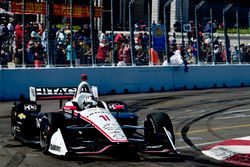2018 IndyCar “will let cream rise to the top” says Penske
Roger Penske says this year’s spec aerokit means IndyCars are better conceptually and practically, they’re safer, and they should ensure driving talent becomes the decisive factor in the series.

Richard Dole / Motorsport Images









Although Penske and Chevrolet appeared to have an advantage over their respective opposition during the three-year era in which engine manufacturers supplied aerokits, Penske said he had no problem switching to Dallara’s spec package.
Penske said: “The car is harder to drive which is exactly what we wanted and the good news was that it wasn’t an expensive changeover. We kept the basic chassis, running-gear, suspension, and obviously the upgraded engines have helped.
“The [new] aerokit took a lot of downforce out and it makes the car safer to drive. The guys say that if the car slides they can catch it.
“So it’s been a home run, and from our tests the reliability has been very good.”
Ever since IndyCar returned to Phoenix in 2016, Penske and his driver coach, legend Rick Mears, have said that the speed through turns at the 1.022-mile ISM Raceway have gotten out of hand, especially since drivers didn’t have to lift off the throttle. The new car has reduced apex speed but its lack of drag means it can still reach the same terminal speed on the straights, thus forcing drivers to feather the throttle or even brake for the turns when running used tires. Penske said that was a welcome change.
“Any time we can take corner speed out of a short oval like Phoenix – and it will be the same thing at Iowa – it will be a big benefit to safety,” he commented, “and it will also increase the ability of the drivers to go side by side in the corners.”
Asked if he felt the removal of the rear bumper pods was a retrograde step for safety reasons, he replied: “There’s always that chance that if someone stops in front of you, you can go over the rear wing, and I guess that’s still a possibility…"
Team president Tim Cindric chipped in: “Keep in mind, that when we ran the bumper pods, we were under caution [at St. Pete] and JR Hildebrand flew over Will. The pods didn’t stop that car even under caution [speeds] so I’m not sure how effective they were.”
Added Penske: “And it was a much higher cost. Every time we lost one it was probably $5-6000 to replace, and there was debris to clear up.
“So it’s been a good process by IndyCar to come up with a design like this. And with the drivers all saying it’s harder to drive, I think it will let the cream rise to the top, which is good.”
Be part of Motorsport community
Join the conversationShare Or Save This Story
Subscribe and access Motorsport.com with your ad-blocker.
From Formula 1 to MotoGP we report straight from the paddock because we love our sport, just like you. In order to keep delivering our expert journalism, our website uses advertising. Still, we want to give you the opportunity to enjoy an ad-free and tracker-free website and to continue using your adblocker.























Top Comments